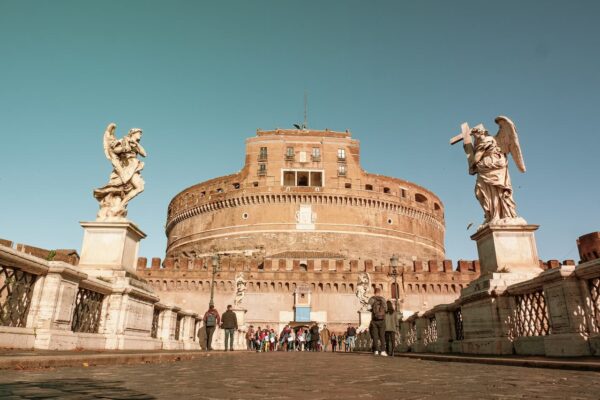When one thinks of Rome, it is impossible not to visualise before one’s eyes the image of the majestic cylinder of Castel Sant’Angelo, but not everyone knows what hides inside this ancient and marvellous fortress!
If you are curious about what you can see inside the walls of Hadrian’s Mausoleum, this article is just what you are looking for;
Together we will go inside the castle, on a virtual but no less punctual visit of its ancient and more modern surroundings;
I will combine the description of the rooms, courtyards and works of art with historical notes and curiosities, guaranteeing you a complete experience and providing you with all the tools you need to prepare for visiting the marvellous Castel Sant’Angelo;
Are you ready to follow me on this long virtual tour? Very well, let’s begin!
WAIT A MOMENT! Before we begin our walk, I want to give you a piece of advice: keep in mind that, given the celebrity of this splendid building, to visit the interior of Castel Sant’Angelo you will almost certainly run into a long queue at the ticket office. To get inside the castle and skip the queue, I highly recommend you buy your entrance ticket online. Click below to book your entrance and enter Castel Sant’Angelo in an instant.

Skip-the-line ticket Castel Sant’Angelo Rome: fast access
Buy online. Choose your preferred time. Visit Rome’s Castel Sant’Angelo, the Ponte dell’Angelo, the prisons and much more.
You can cancel free of charge up to the day before the visit.
What’s Inside Castel Sant’Angelo
Contents
Within its walls, the old Mole Adriana holds an incredible amount of stanze, stories and secrets to discover. Fortunately for us, much of its interior can now be visited by purchasing a ticket to the National Museum of Castel Sant’Angelo;
For your convenience, I have decided to divide the rooms according to the classification of the museum, so that you can use this article of mine as a guide during your visit to the castle.
Level 1
At this level you can find the Ambulacrum of Boniface IX, the Chapel of the Condemned, the Firing Courtyard, Dromos and Atrium, the Helical Ramp and other rooms. Let’s go!
The Ambulacrum of Boniface IX
This is the first room in which you will find yourself once you have passed through the entrance gate: a ring corridor between the enclosure and the castle, created at the end of the 14th century from the insulation work on the central cylinder;
Commissioned by Boniface IX to the Florentine architect Niccolò di Piero Lamberti, the work brought to light the original walls from the Roman period of the Mole Adriana basement. Parts of the original walling and paving still survive near the main entrance and the secondary access gate;
The base of the cylinder, with its rough masonry, shows in its cavities the trace of the antique marble covering, removed in the looting by the Roman people during the XIV century;
The annular corridor still contains fragments of statues and antique architectural elements. From here, it is possible to access several rooms: the Cordonata of Paul III, the ramp to the Bastion San Marco, the Armeria of Clement X and above all the ancient access to the castle and its vestibule: the Dromos and the Atrium.
The Chapel of the Condemned

On the ground floor of the Armoury of Clement X building, overlooking the Court of Fucilations, you will find the Capel of the Condemned.
Originally a dust storeroom, this room was reorganised several times and only in the second half of the 18th century did it become a prayer room.
In the early 20th century, the chapel was also equipped with a sagristy.
Except for extraordinary events, this environment is not normally open to the public.
The Shooting Courtyard
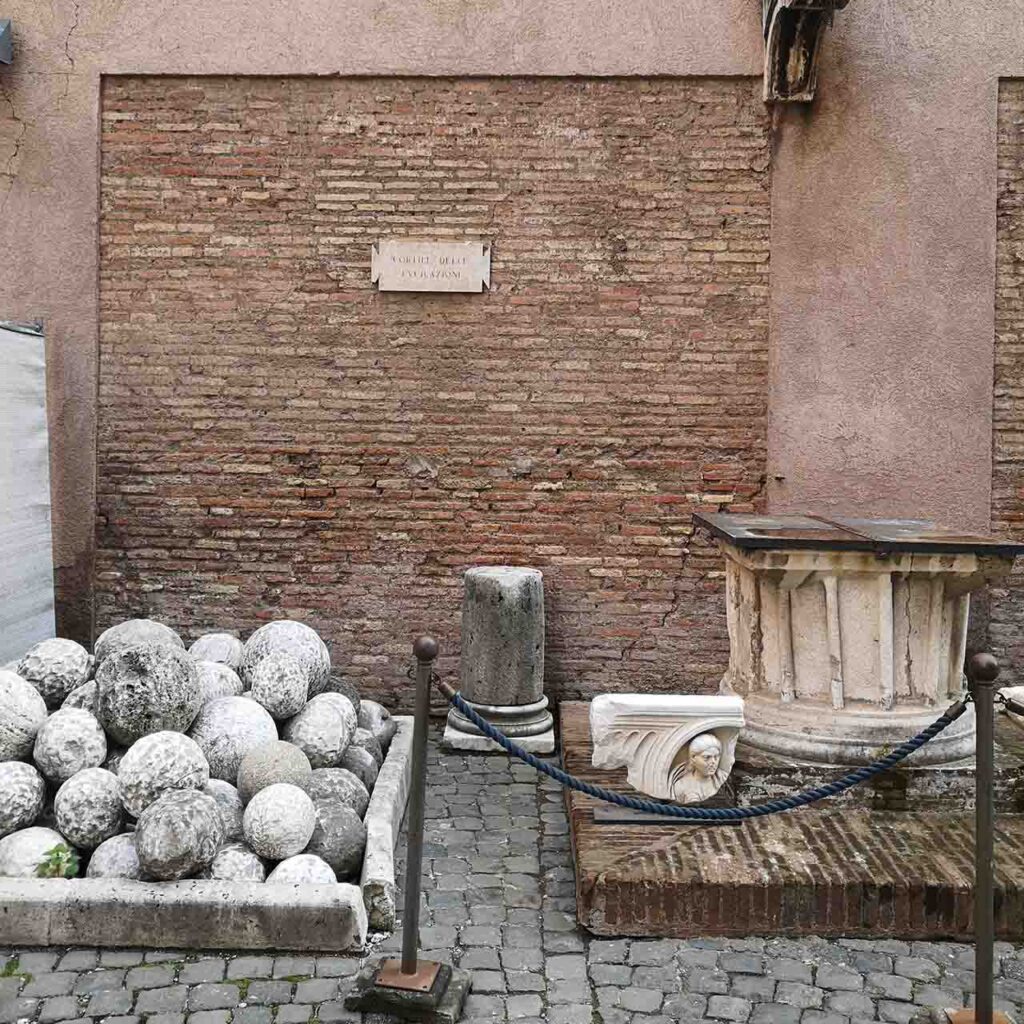
In the north-east corner of the walls, bordered by the porch of the Capella dei Condannati, you will find the Cortile delle Fucilazioni;
It was not until the Modern Age that the room gained its current name: the hypothesis is that capital punishments that were not intended to be made public were carried out here;
The vera of the well, as well as the two benches present in the environment today, emerged from excavations carried out in this area in the early 20th century.
Dromos and Atrium
The Dromos, a twelve-metre high vaulted corridor, placed on an axis with the Ponte Sant’Angelo, represents the ancient entrance to the imperial tomb;
Made of large blocks of travertine (originally covered with marble slabs), this corridor leads to a square cell: the Atrium, in effect the access to Hadrian’s Mausoleum;
At the far end of this room, a nicchia once housed a statue of Emperor Hadrian;
From here starts the Helicoidal Ramp that leads to the Hall of Urns.
The Helical Ramp
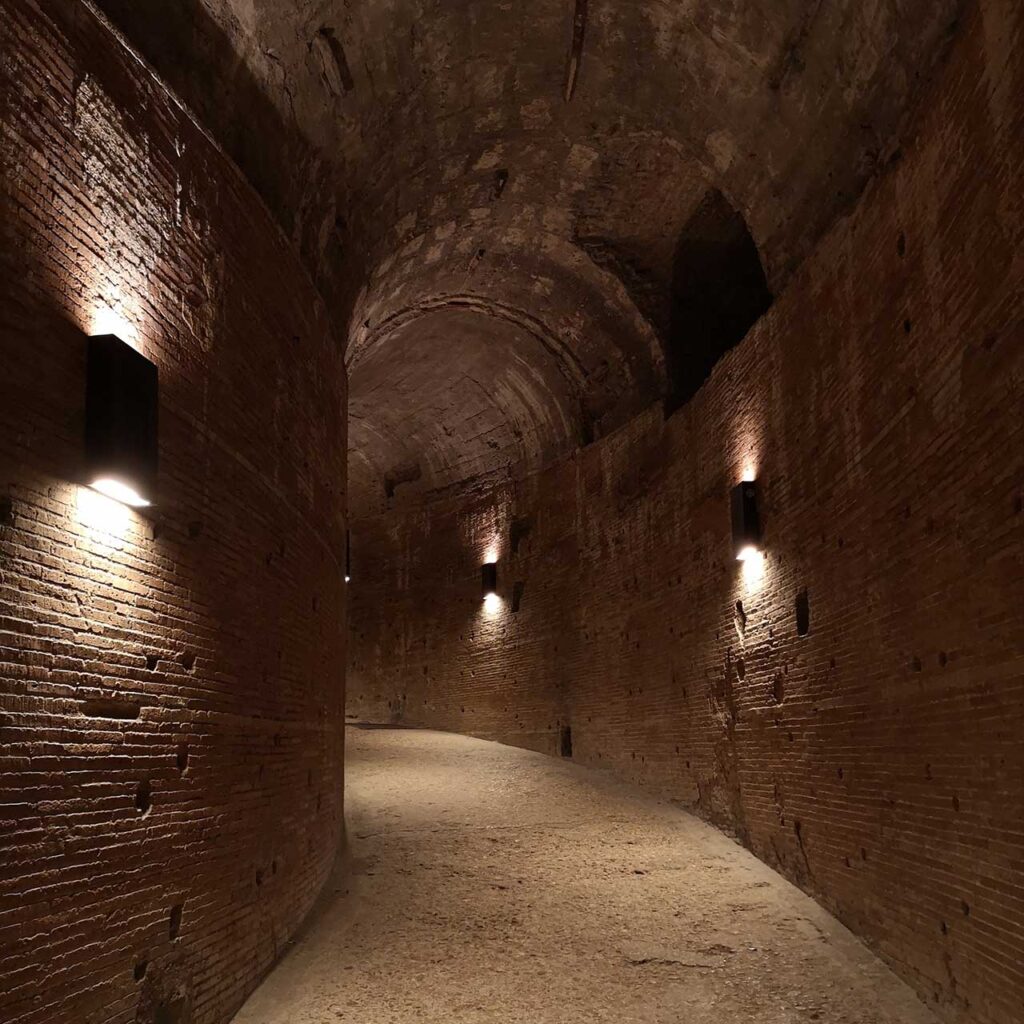
This is the spiral ramp that, from the Atrium, in the original conformation of the Mole Adriana reached directly to the Sala delle Urne;
A corridor six metres high and three metres wide, originally decorated like the Dromos and the Atrium, but with brick walls and a mosaic flooring of which few traces survive today;
The ramp has no outward openings, but only upwards, through four vents that are also useful for transporting materials;
Interred for defensive reasons, in the first half of the 19th century the ramp was reopened, re-establishing the original connection between the different levels of the mausoleum.

Skip-the-line ticket Castel Sant’Angelo Rome: fast access
Buy online. Choose your preferred time. Visit Rome’s Castel Sant’Angelo, the Ponte dell’Angelo, the prisons and much more.
You can cancel free of charge up to the day before the visit.
Level 2
At this level you can find the Cordonata di Paolo III, the Marcia ronda, the Bastione San Matteo, the Bastione San Marco, the Passetto di Borgo, the Bastione San Luca, the Bastione San Giovanni, the Rampa diametrale and the Sala delle Urne and the Armeria di Clemente X.
The Cordonata of Paul III
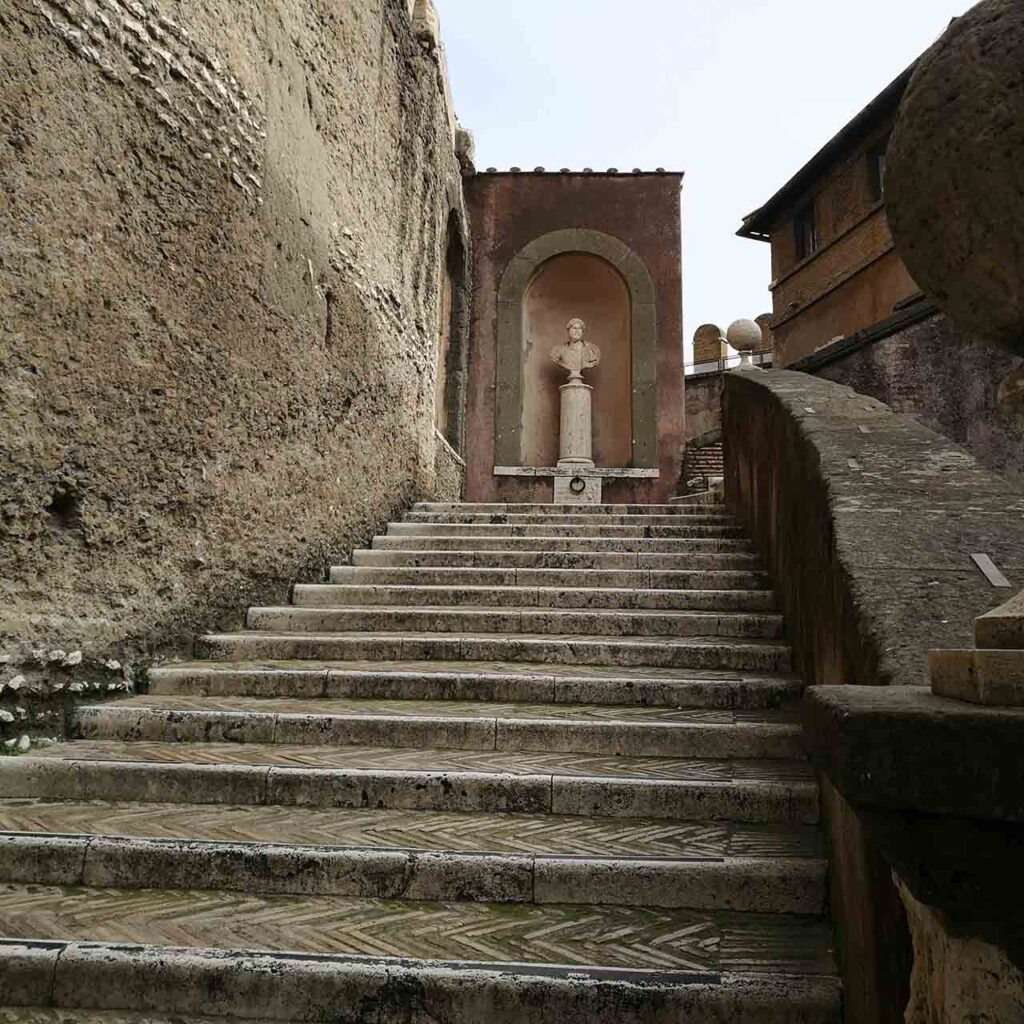
The Cordonata di Paolo III connects the area of the entrance gate to the Marcia ronda, and then to the iron bridge through which one enters the inside of the mausoleum.
It was built in 1545, replacing the link that had previously been built by the Florentine Niccolò di Piero Lamberti on the commission of Boniface IX. The construction of such a link was part of a plan to enhance the defensive structure, which also envisaged the surrounding of the Helicoidal ramp as an access to the castle.
The new entrance was secured by means of a front building constructed over the old entrance and equipped with a drawbridge.
Two niches along the staircase house the bust of Emperor Hadrian and a togatus, dating from around the mid 2nd century.
At the foot of the Cordonata is a marble ball supported by a pilaster on which were originally engraved the letters C.T.P., initials of Crispus Tiberius Prefect who was Castellan during the pontificate of Paul III.
The Marching Patrol (“Marcia Ronda”)

The Marcia ronda is the walking path on the top of the outer walls, i.e. on the perimeter of the original basement of the Mole Adriana, and was used over the centuries as a guard path by the castle sentries;
The walkway connects all four bastions and has numerous access points, including the Cordonata di Paolo III;
Where it connects to the Bastione San Marco, the walkway leads to the protected passageway towards the Vatican known as the Passetto di Borgo.
The Bastion of San Matteo

The four bastions, located at the angles of the old basis of the Mole Adriana, were built between the 15th and 16th centuries;
More precisely, construction was started under the pontificate of Niccolò V around 1450 to adapt the defensive structure to the new firearms;
At that stage, however, only three bastions were built, leaving the very area where the St. Matthew’s Bastion now stands unprotected;
It was thanks to the design of the Florentine Santo di Giovanni that, at the instigation of Alessandro VI Borgia, the bastion was built fifty years later;
Under Pio IV Medici, shortly after the half of the 16th century, the coronamento of the bastion was elevated to the height of the Marcia ronda;
Urban VIII Barberini (the one who financed the construction of Palazzo Barberini in Rome) in 1625 ordered another rampart enhancement that concealed the earlier architectural phases.
The Bastion of San Marco

Built under the pontificate of Niccolò V, the original tower was incorporated at the time of Alessandro VI Borgia into a wall containing cannons inside.
It gained its current appearance under Pio IV Medici: at his instigation the level of the Bastion was raised to the point of occluding the original tower inside, and a helical ramp was built to connect to the Marcia ronda.
Inside, sixteen cells were opened for use as cannonry. A building was constructed close to the rampart, which became the barracks, dormitory and weapons store, and which now houses part of the offices and the library of the museum.
Under Urbano VIII Barberini the bastion was adapted to the use of heavy artillery. Again, the intervention ended up concealing the earlier architectural phases.
The Bastion is still today connected to the Passetto di Borgo.
Il Passetto di Borgo
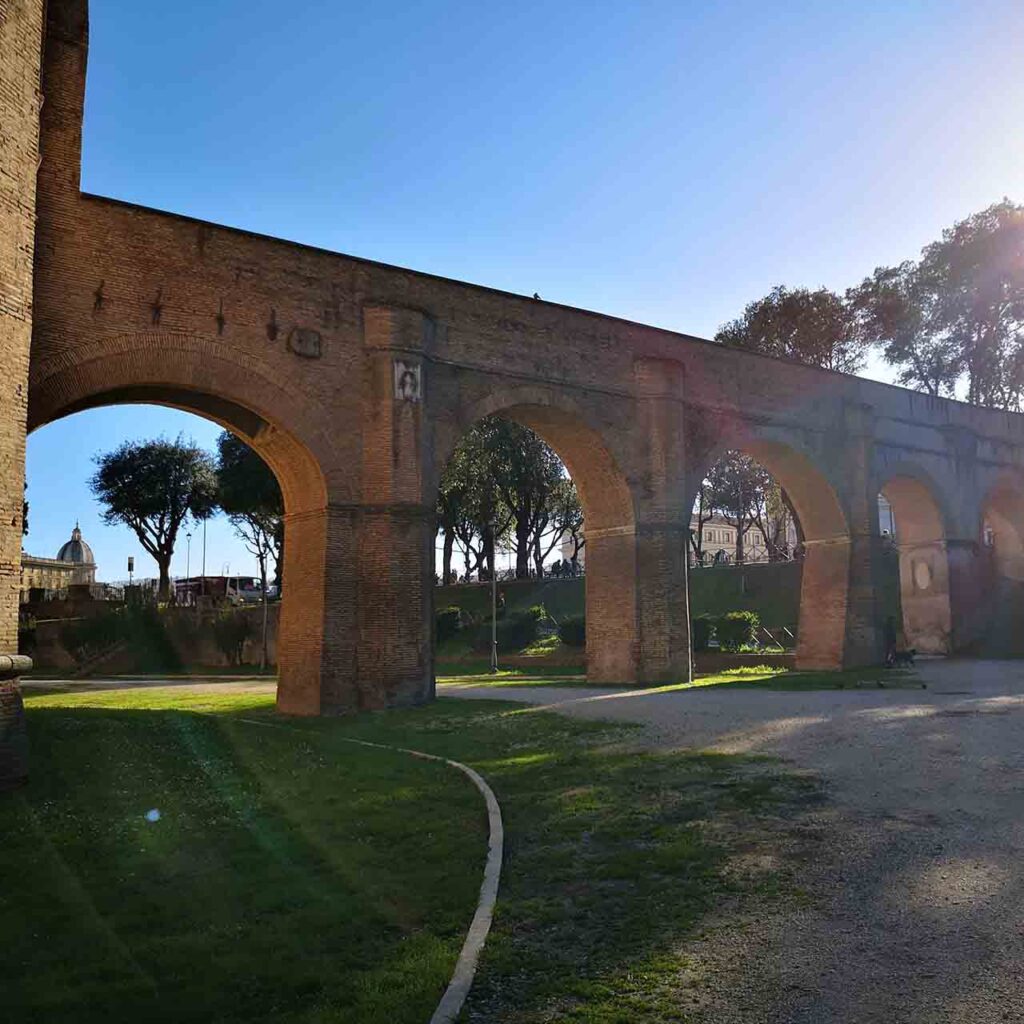
Also called the Corridor of Borgo, it is the protected passageway connecting the St. Mark’s Bastion to the Vatican Apostolic Palace.
An eight hundred metre elevated corridor that represents the longest remaining stretch of the ancient Leonine Walls, erected by Pope Leo IV in the mid-9th century with the aim of defending the Civitas Leonina from the danger of Saracen invasions.
The corridor was provided with a covered passageway during the restoration of the Vatican Walls. The purpose was to guarantee an escape route for the popes, as well as to create a protected link between the Vatican and the Mole Adriana, already a fortress used for defensive purposes.
Who is responsible for this improvement, however, is still a matter of debate among experts. For some, it belongs to Niccolò III and the restructuring he ordered in 1278, for others to Bonifacio IX who, more than a century later, is said to have initiated the work completed by Baldassarre Cossa, the antipope John XXIII.
In the mid 15th century it was the turn of Niccolò V, followed thirty years later by the works of Sisto IV. At the beginning of the 16th century it was instead Pope Alexander VI who wanted a massive rebuilding of the walls.
It is not surprising, then, that the popes relied so heavily on this strategic passageway to conduct prisoners by stealth to the prisons of Castel Sant’Angelo, as well as to escape in case of siege.
This, historically, occurs in at least two cases: the invasion by the French militia of Carlo VIII in Carlo VIII in 1494, which saw the pontiff Alexander VI Borgia come to safety thanks to the Passetto, and the famous Sack of Rome perpetrated by the lansquenets of Carlo V in 1527, when Pope Clemente VII took refuge in Castel Sant’Angelo while most of the Swiss guards were massacred. The marks left by the arquebus shots of the German mercenaries are still visible on the walls today!
In the year 2000, on the occasion of the Jubilee proclaimed by Pope John Paul II, the Passetto di Borgo returned accessible to the public along with other important architectural works.
Today, however, it is only accessible on special guided tours;
For more information, read my article on the Passetto di Borgo.
The Bastion of San Luca
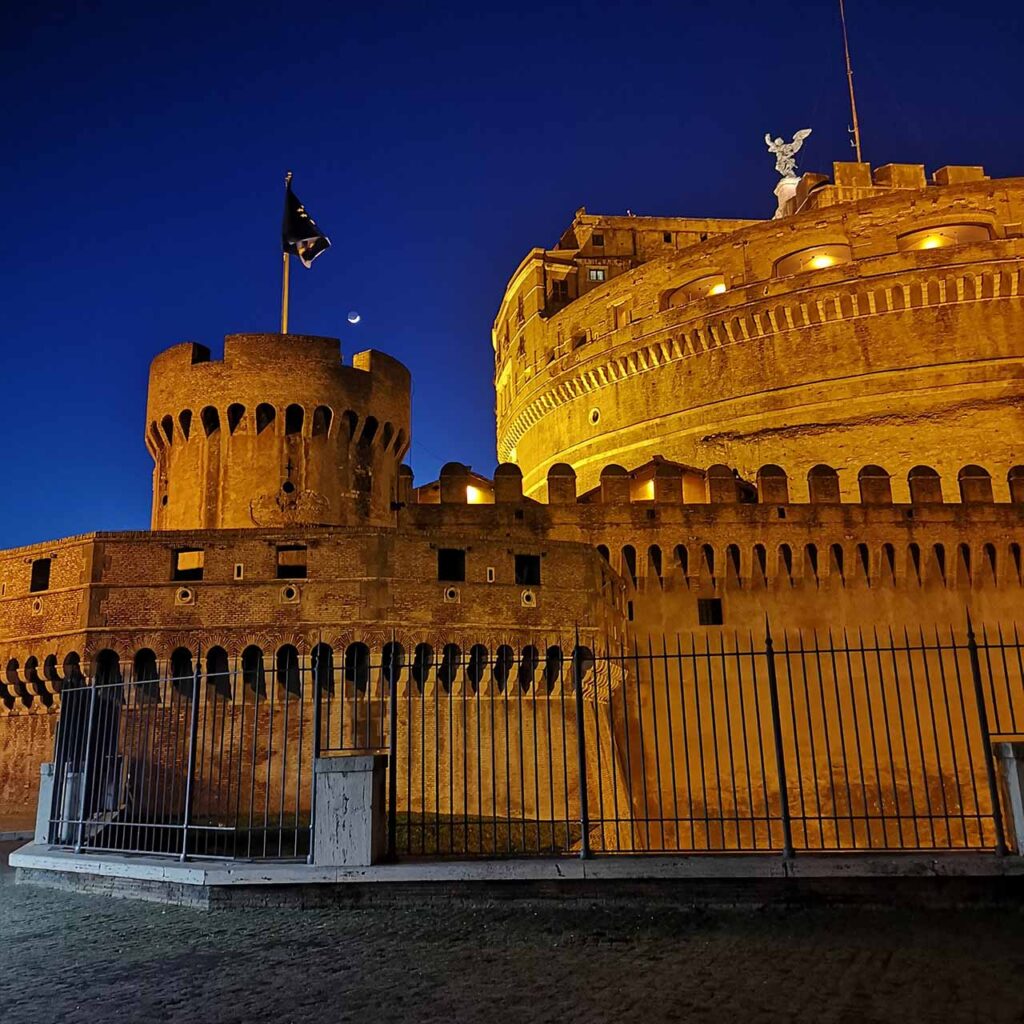
Also built at the instigation of Pope Niccolò V, the keep was later adapted to the use of firearms under the pontificate of Alessandro VI Borgia;
The raising up to the circular walkway, ordered by Pio IV Medici, did not alter the structure;
It was restructured, after 1625, by order of Urban VIII Barberini. The restructuring, by Giulio Buratti and Vincenzo Maculano da Fiorenzuola, as in the other cases, concealed the previous architectural phases.
The Bastion of San Giovanni
Constructed under the pontificate of Niccolò V as a corner tower, it was upgraded at the instigation of Alessandro VI Borgia in 1495;
Surrounded by perimeter walls, containing cannons inside, the bastion thus became a polygonal bulwark;
Towards the end of the 19th end of the 19th century it was almost entirely rebuilt under General Mariano Borgatti to house part of the Museo del Genio Militare;
As evidence of the first museum layout of Castel Sant’Angelo, we can still find a reconstruction of a 16th-century gunsmith’s workshop in the turret.
The Diametrical Ramp
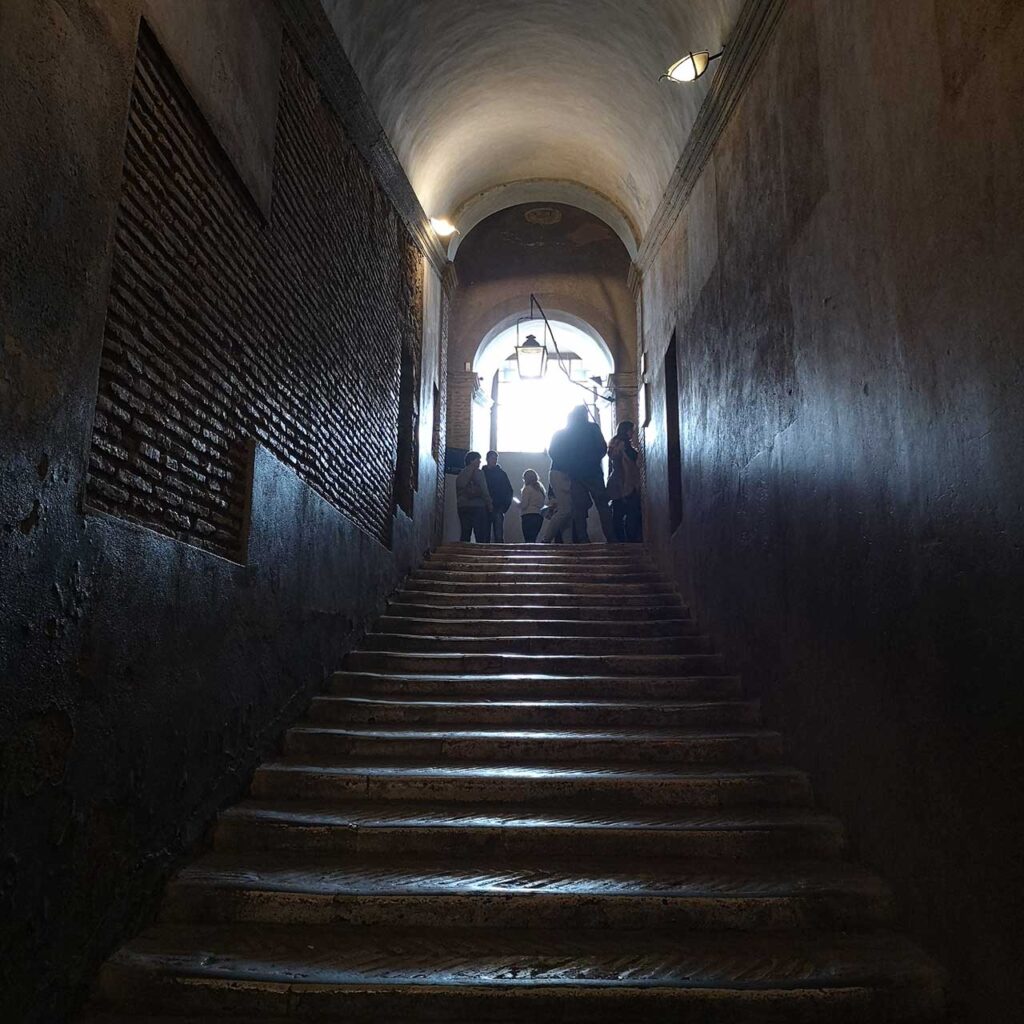
Long attributed to the pontificate of Alessandro VI Borgia, the construction of this ramp that diametrically cuts through the Roman cylinder actually took place a century earlier: it was Niccolò Lamberti, in fact, who built it for Bonifacio IX.
With this new ramp, a more protected access than the previous one was guaranteed. Once the Helical Ramp had been buried, this remained for a long time the only access opening to the cylinder of the mausoleum.
At the meeting point between the two ramps, a botola is still visible today, a weapon of defence for those who managed to penetrate inside the castle walls, while in the jambs of the Roman door leading to the Sala delle Urne, two firing mouths were carved.
The tomb chapel can be crossed thanks to a elevated bridge built in 1825 by Giuseppe Valadier.
Continuing on, the ramp takes on the appearance of a 16th-century cordonata and climbs up to the Cortile dell’Angelo.
The Urn Room
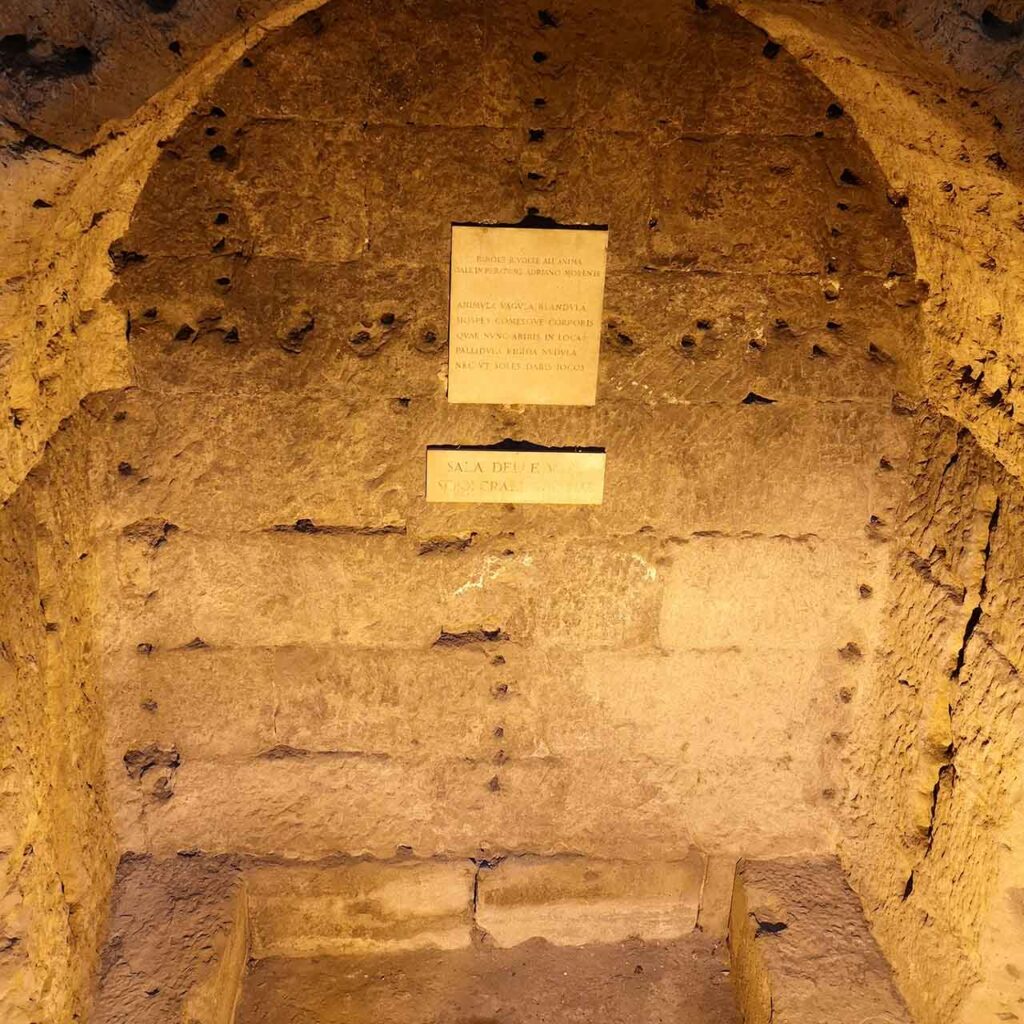
It is the holiest room of the original mausoleum. Square in plan, about eight metres on each side, the room held the remains of the imperial family until the time of Caracalla.
Constructed of blocks of travertine, originally decorated in marble, the room has two large niches on the side walls, where the cinerary urns were probably kept.
On the left wall is a marble plaque bearing a solemn inscription in Latin. These are the words (in italian) that the Emperor Hadrian dedicated to his own soul:
Piccola anima smarrita e soave,
Emperor Hadrian
compagna e ospite del corpo,
ora t’appresti a scendere in luoghi
incolori, ardui e spogli,
ove non avrai più gli svaghi consueti…
The Armoury of Clement X
Leaning against the Bastion San Luca, the building still displays a marble plaque as a reminder of the work undertaken by Clemente X in 1675, when it was reorganised to house the prisons on the intermediate floor;
The upper floor retained its function as a armery, while the former powder store on the ground floor became a place of worship in the mid-18th century: the Cappella dei Condannati;
In the early 20th century the top floor was rebuilt. The old monumental doors, now reassembled, can be seen in the Halls of Clement VIII.

Skip-the-line ticket Castel Sant’Angelo Rome: fast access
Buy online. Choose your preferred time. Visit Rome’s Castel Sant’Angelo, the Ponte dell’Angelo, the prisons and much more.
You can cancel free of charge up to the day before the visit.
Level 3
At level 3 you will find the historical prisons and the “Oliare”. let’s start!
Historical Prisons

Famous for having ‘hosted‘ (and sometimes seen die) many illustrious personalities, the historic prisons are accessible from the Alexander VI Courtyard, also known as the Theatre Courtyard.
Like other areas of the castle, however, the prisons are not always open to the public, but on the occasion of extraordinary openings it is possible to visit them.
A little door on the courtyard leads to a stairs that leads to a wide rectangular room, known as the Parlatoio, where prisoners of the Papal States were interrogated, very often through the torture. Some of the instruments are still preserved in special deposits, while illustrations show us the torture techniques of the prisoners carried out by their torturers.
Beyond this room is a dark and narrow semi-circular corridor onto which three narrow cells open. There, a dim light penetrates through the narrow grates overlooking the courtyard.
On the floor of the same, protected by grates, we can see some caves that have brought to the surface the ancient Roman walls.
Next, a small passageway leads to the last two prisons, also lit only by tiny openings in the courtyard.
The last of these is famous for having ‘hosted’ the Florentine artist Benvenuto Cellini for almost a year. The small room that, as we ascend, we encounter on our right, is precisely the outdoor latrine from which, according to the celebrated tale, the artist allegedly managed to evade.
To the left is the Oliare, the room where oil was stored in special terracotta jars.
Also visible from the prisons is the window of the Hall of Justice, where the death sentences were read to the inmates of Castel Sant’Angelo.
For more information, read my article on the Prisons of Castel Sant’Angelo.
Le Oliare
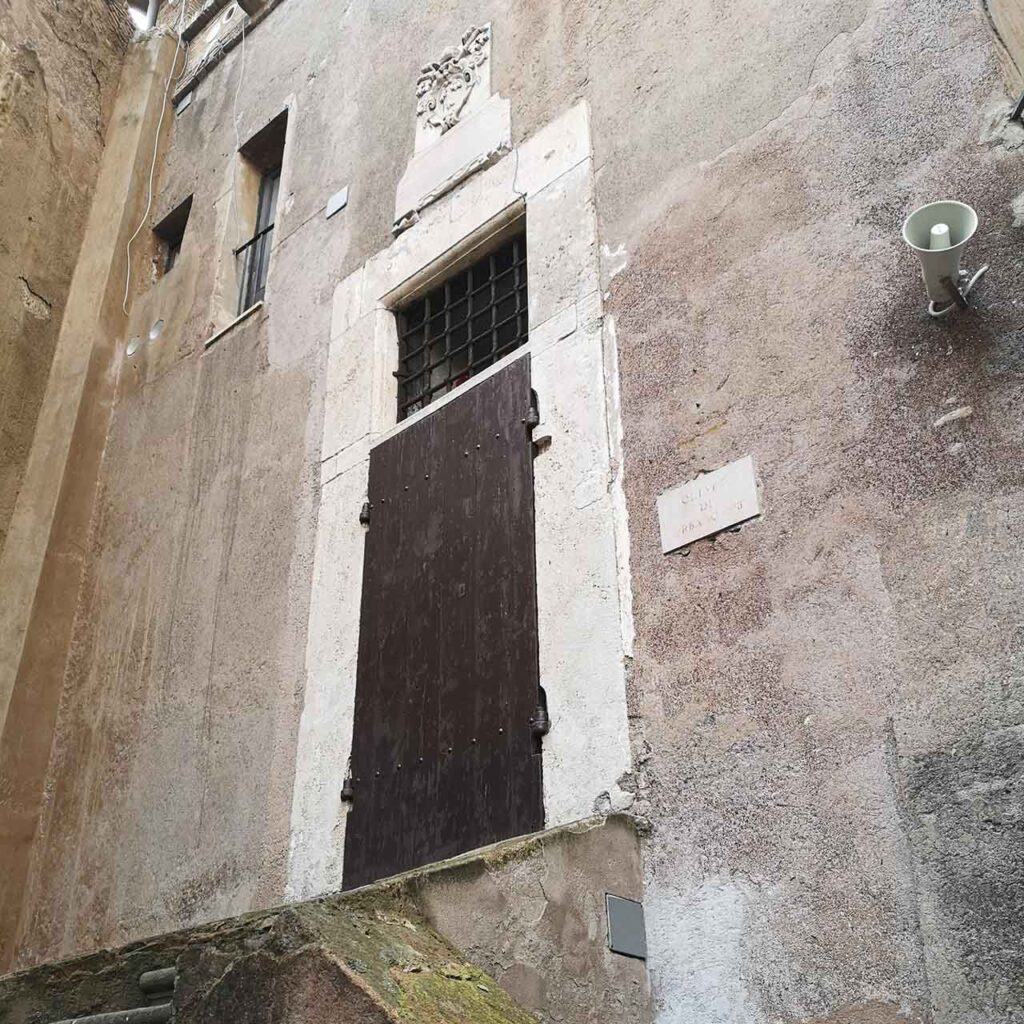
The Oliare, probably of Medieval origin, was certainly restructured under the pontificate of Alexander VI Borgia in the early 16th century.
It is a series of compartments located below the Court of Alexander VI and set against the curve of the original cylinder.
On one side we find two large rooms containing eighty-three terracotta jars.
The jars originally served to preserve oil, which was very useful for lightening rooms, as well as for food and military use.
In the centre of each chamber are three openings that correspond to as many tombini in the courtyard. These manholes, made of travertine and equipped with loops for opening, were in fact used to spill oil directly from above.
On the other side we find five circular pits, dug within the original drum of the Mole Adriana, which once served as silos for grain. Each pit, again, corresponds to an aperture in the floor of an upper room.

Skip-the-line ticket Castel Sant’Angelo Rome: fast access
Buy online. Choose your preferred time. Visit Rome’s Castel Sant’Angelo, the Ponte dell’Angelo, the prisons and much more.
You can cancel free of charge up to the day before the visit.
Level 4
At level 4 you can find the Cortile dell’Angelo, the Armouries, the Halls of Clement VIII, the Hall of Justice, the Hall of Apollo, the Chapel of Leo X, the Halls of Clement VII, the Courtyard of Leo X, the Bath of Clement VII, the Courtyard of Alexander VI and the Halls of Alexander VI and other rooms. Follow me!
The Cortile dell’Angelo

Also known as the Court of Honour, this court took its current form in the first half of the 16th century, between the pontificate of Leo X Medici and that of Paolo III Farnese;
It is initially conceived as a presentational space and, above all, as a huge to the fabulous papal apartments.
The courtyard, with a rectangular plan, is enclosed on one side by the Armerie, and on the other by the old walls of the Mole Adriana, to which the sumptuous halls of the papal residence are attached.
The entrance façade is embellished with a double archway with a central nicchia, commissioned by Paolo III Farnese from Raffaello da Montelupo.
The second fornix frames another ramp of stairs that ascends to the circular walkway.
The side facing the entrance, on the other hand, is enriched by the Edicule of the Chapel of Leo X, created in the early 16th century to a design by Michelangelo Buonarroti.
Both elevations feature a niche housing a manly bust, the work of Guglielmo della Porta in the mid 16th century.
The element that gives the courtyard its name is found in the centre: it is in fact the statue of St Michael the Archangel made in 1544 by Raffaello da Montelupo.
Of the many sculptures placed on the top of Castel Sant’Angelo, apart from the present one, this is the only one that has survived to the present day.
The Archangel Michael, made of marble, is depicted in a long robe in the act of sheathing the sword. The armour is supported by shoulders showing the Farnese Lily.
The size of the head, which is disproportionate to the rest of the body, is justified by the original location, which envisaged a bottom-up view.
The wings, made of originally gold-plated metal, are perforated to decrease wind friction force.
Once replaced, after more than two hundred years spent on the top of the castle, the sculpture was transported to a corner of the Paul III staircase and then, at a later date, to its current location, namely in this court that, in 1910, took its name.
Below, behind the statue of St Michael the Archangel, a large wolf-mouth window provides light to the imperial tomb below, while above it rises the complex of the papal apartments.
For more information, read my article on the Angel Courtyard.
The Armouries
The Armerie is a two-storey building on one side of the Angel’s Courtyard.
At the level of the courtyard it is called the Lower Armoury, while the Upper Armoury is located at the level of Alexander VII’s Giretto.
Probably built in the 500s, they have been restructured several times, so much so that it is difficult to imagine what their original layout was.
The interior is composed of communicating rooms that are now bare, with the exception of a Farnesian emblem – the Festina Lente – and a few architectural elements such as the chimney and the wooden ceiling of the kitchen.
The name is due to the service function that the building performed for the truces guarding the upper part of Castel Sant’Angelo.
The Halls of Clement VIII
The Halls of Clement VIII are two communicating rooms accessed from the Cortile dell’Angelo.
These rooms, repeatedly restructured, are now entirely bare.
Recent renovations have included some architectural elements salvaged from other parts of the castle, such as the marble portal leading to the Sala della Giustizia, the monumental fireplace, dating back to the pontificate of Urban VIII Barberini and decorated with his heraldic symbols, and the two travertine portals from the Armoury of Clement X.
Currently, these two rooms host temporary exhibitions.
The Hall of Justice
This room was carved inside the original Roman core, as can be seen from the squared blockwork of the walls and the thickness of the wall structure.
The name Room of Justice is modern and is linked to the assumption that trials were held here and sentences were read out to prisoners in Castel Sant’Angelo.
It is possible that, in the past, the room was also used as a chapel.
The winged figure fresco on the back wall, painted by Domenico Rietti – known as Zaga – around the middle of the 16th century, is today interpreted as a depiction of St. Michael the Archangel bearing the symbols of Justice.
The Hall of Apollo

The main room of the first floor of the papal apartments, this large vaulted hall was built under the pontificate of Niccolò V.
The adjacent rooms of the Chapel, the Halls of Clement VII and the Bathroom of Clement VII were added from the 16th century.
The decoration was commissioned by Paolo III Farnese to Perin del Vaga and his collaborators, who were already working on the upper floors.
The walls and the vault display a rich grotesque decoration on a white background.
On the ceiling are ten panels showing some stories of the god Apollo and giving the room its name.
In the lunettes, on the other hand, the Liberal Arts are represented. All these elements recall the myth of the god Apollo and his role as protector of the humanities.
As in the decorations of other rooms ordered by Paul III, here too elements of pagan mythology alternate with papal heraldry, testifying to the love of the pontiff for the Neoplatonic culture.
The room features the Lily of Justice and the Festina Lente, both characteristic of the Farnese family.
The name of the pontiff can be found on the marble fireplace, made by Raffaello da Montelupo, and in the frets of the doors.
The Chapel of Leone X
The Chapel of Leone X (Cappella di Leone X) is the only surviving chapel of the many documented within Castel Sant’Angelo.
As its name suggests, it was built by Pope Leo X Medici and consecrated to Saints Cosmas and Damian, the patron saints of his family.
It is a small environment and, nowadays, almost entirely dirty.
The Paptifical coat of arms, with the characteristic Medicean balls, can still be seen in the centre of the moon vault.
We also find traces of the patron on the floor: the brick tiles that make up the central carpet bear the small figure of a lion in the centre, while those on the border show the Medicean coat of arms.
The altar was made in the XX century as a furnishing element for the chapel. Above it is a bass relief of the Madonna Enthroned with Child, by Raffaello da Montelupo, originally located in another part of the castle.
The chapel also features a small room that served as a sagristy.
A utility staircase leads from this room to the diameter staircase, while another staircase connects the entrance hall to the upper apartments.
The Halls of Clement VII
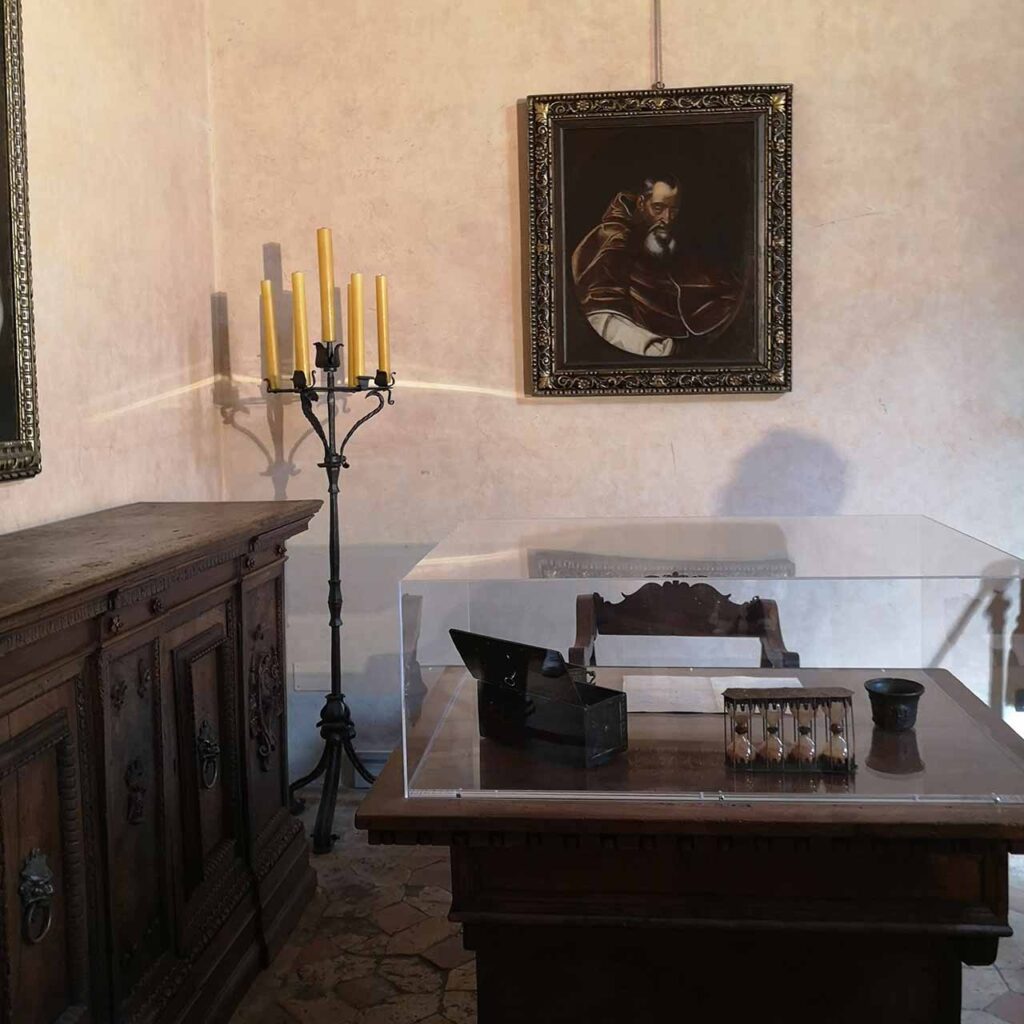
These two rooms, named after the pontefice who ordered their decoration, are the chambers of service for private use reserved by the popes.
The name of Clemente VII Medici can still be found in the inscription in the centre of the coffered ceilings, as well as in the cartigli painted in the fregio of the first room by Michele di Bartolomeo da Lucca and Matteo Crassetti da Terranova.
The frey in the second room was replaced by Innocent X with a painting bearing the heraldic attributes of the family.
The rooms, with large windows, were originally frescoed with the symbols of the house of Medici. They were provided with gradings and seats at the behest of Pope Julius II Rovere.
The cotto floors, which have been restored several times, date back to the pontificate of Paolo III Farnese.
From the first chamber, a door leads to the Courtyard of Leo X. From the second chamber, a door leads to the bathroom of Clement VII, also known as the Stufetta.
The Courtyard of Leo X
Also known as ‘del forno‘, because it was from here that the fires that heated the Stufetta room were lit, this small courtyard was built by Leon X around 1514.
It is likely that, at one time, the small room housed a Italian garden, similar to the one that extended into the Courtyard of Alexander VI.
Opening onto the courtyard are the two windows of the Salons of Clement VII and two doors, on which can be seen the inscription of the names of the pontiffs Giulius II and Leo X.
The Bath of Clement VII
The construction of this room dates back to the pontificate of Julius II della Rovere, while the decoration by Giovanni da Udine, a pupil of Raffaello, was commissioned by Clemente VII Medici.
The room, fitted with a tub and used as a bathroom, was equipped with a heating system connected to a oven accessed from the Courtyard of Leo X.
The heraldic symbols, as well as the mythological scenes linked to the element of water, stand out against a surface covered with a rich grotesque decoration, dense with sea animals and sphinxes.
The cameos of the pope and the castellan Guido de’ Medici are found in the centre of the vault. All around, in imitation of antique cameos, ovals with putti abound.
Venus and Love are the protagonists of four mythological scenes with an aquatic theme, and Greek mythology also returns in the seven thrones of the main divinities of Olympus, purposely left empty to create the illusion that the occupants were taking a bath with the pontiff.
The two spouts of the basin, bearing the symbols of a basin and a brazier, testify to the fact that the pope had access to hot and cold water.
The Courtyard of Alexander VI
Also called ‘the theatre‘ by virtue of the presentations that took place here in the time of Leo X, the courtyard has a semi-circular shape that traces that of the original cylinder of the Mole Adriana.
Testimonies from the 16th century tell us of a rich garden, with tall trees, that extended into the space of this courtyard: we find it in the diary of the German jurist Johann Fichard, dating back to 1536, in a fresco by Giovan Battista Montano from 1565 and in the autobiographical account of the artist Benvenuto Cellini.
Even today, beneath the floor, there is a large cistern possibly dating back to the original tumulus arrangement. In this cistern, the water of the Tiber was purified by decantation. Visible from the courtyard is the marble well, decorated with the Borgia coat of arms, which drew from it.
The other openings in the floor served instead to give light to the room of the Historic Prisons or as an upper access to the Oliare.
The “Salette” of Alexander VI
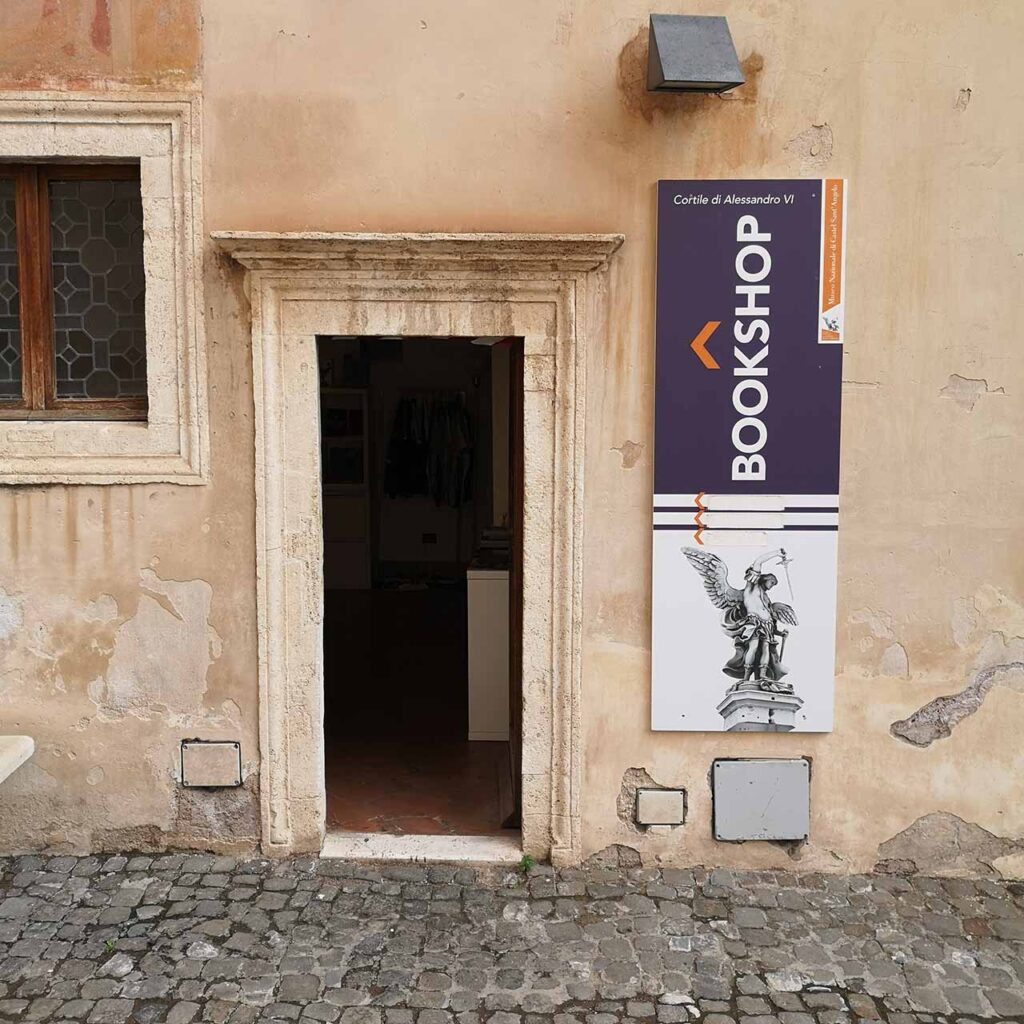
The “Salette” of Alexander VI are a set of interconnected small rooms in a series overlooking the Alexander VI Courtyard.
Originally used for the Historic Prisons, today the rooms host temporary and permanent exhibitions, as well as being the site of the Bookshop of the National Museum of Castel Sant’Angelo.

Skip-the-line ticket Castel Sant’Angelo Rome: fast access
Buy online. Choose your preferred time. Visit Rome’s Castel Sant’Angelo, the Ponte dell’Angelo, the prisons and much more.
You can cancel free of charge up to the day before the visit.
Level 5
At level 5 you will find Julius II’s Loggia, Pius IV’s Giretto and Rooms, Paul III’s Loggia, Alexander VII’s Giretto, la Sala Paolina, the Perseus Room, the Room of Cupid and Psyche, the Armoury and other rooms. Let’s begin!
The Loggia of Julius II
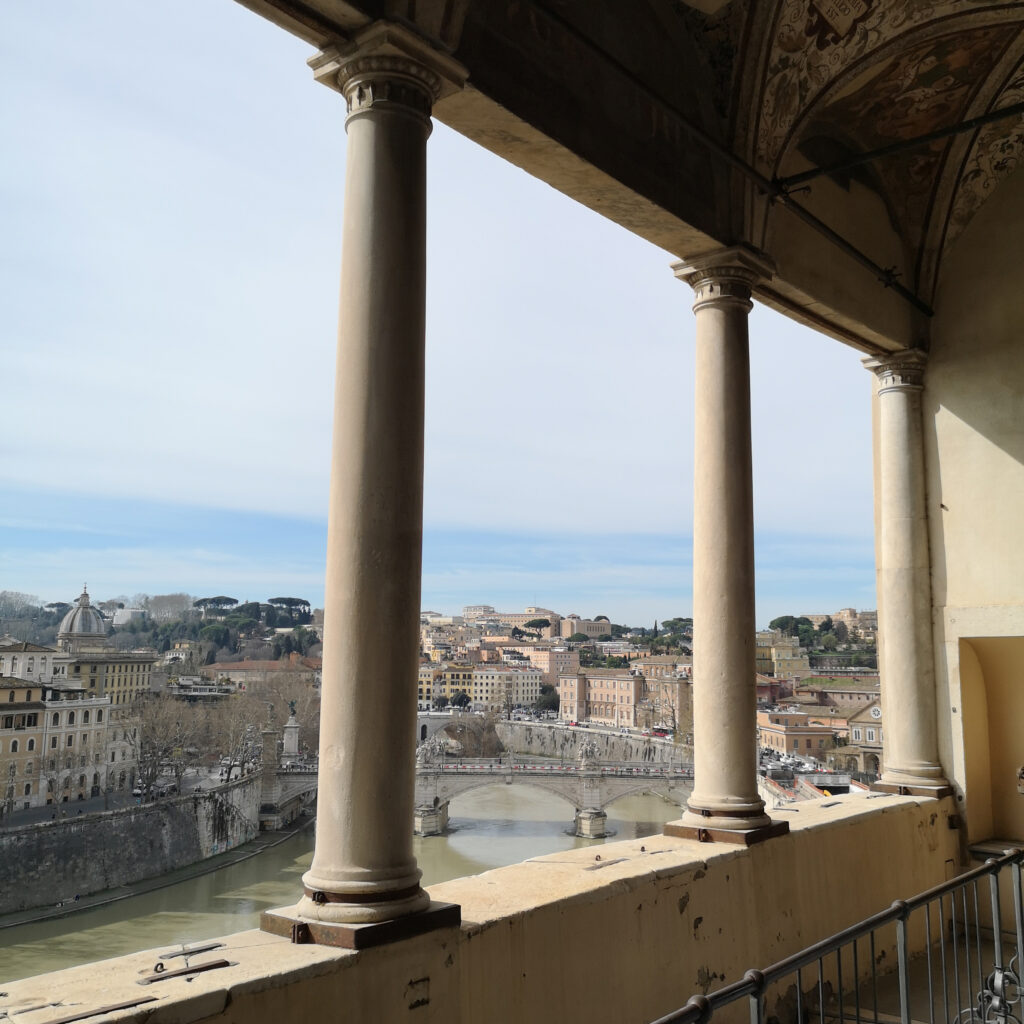
The Loggia of Julius II is the vaulted room of access to the Sala Paolina. Overlooking the The Tiber, the loggia was built at the behest of Julius II and under the supervision of Castellan Marco Vigerio by the architects Giuliano da Sangallo and Donato di Angelo di Pascuccio, known as Bramante.
The elevation consists of a marble parapet and four columns, two of which are set against the jambs.
On the architecture, the inscription “IVL II PONT MAX ANNO II” under the stem of Oak is visible from the outside.
The capitals of the columns are decorated with small acorns and leaves, the heraldic motif of the pontiff’s family.
The pinnacles of the vault are decorated with vegetable swirls that stand out against a light field, while on the sails we find, among the decorative motifs, acanthus spirals, surmounted by putti and caryatids.
Remnants of the same motifs also survive on the lunettes of the walls. Also painted on the vault are four cartouches bearing four Latin mottos alluding to the function of this lodge of blessings.
Recently, the paintings have been attributed to Michele del Becca da Imola and Pier Matteo d’Amelia.
The Giretto and the Salette of Pius IV
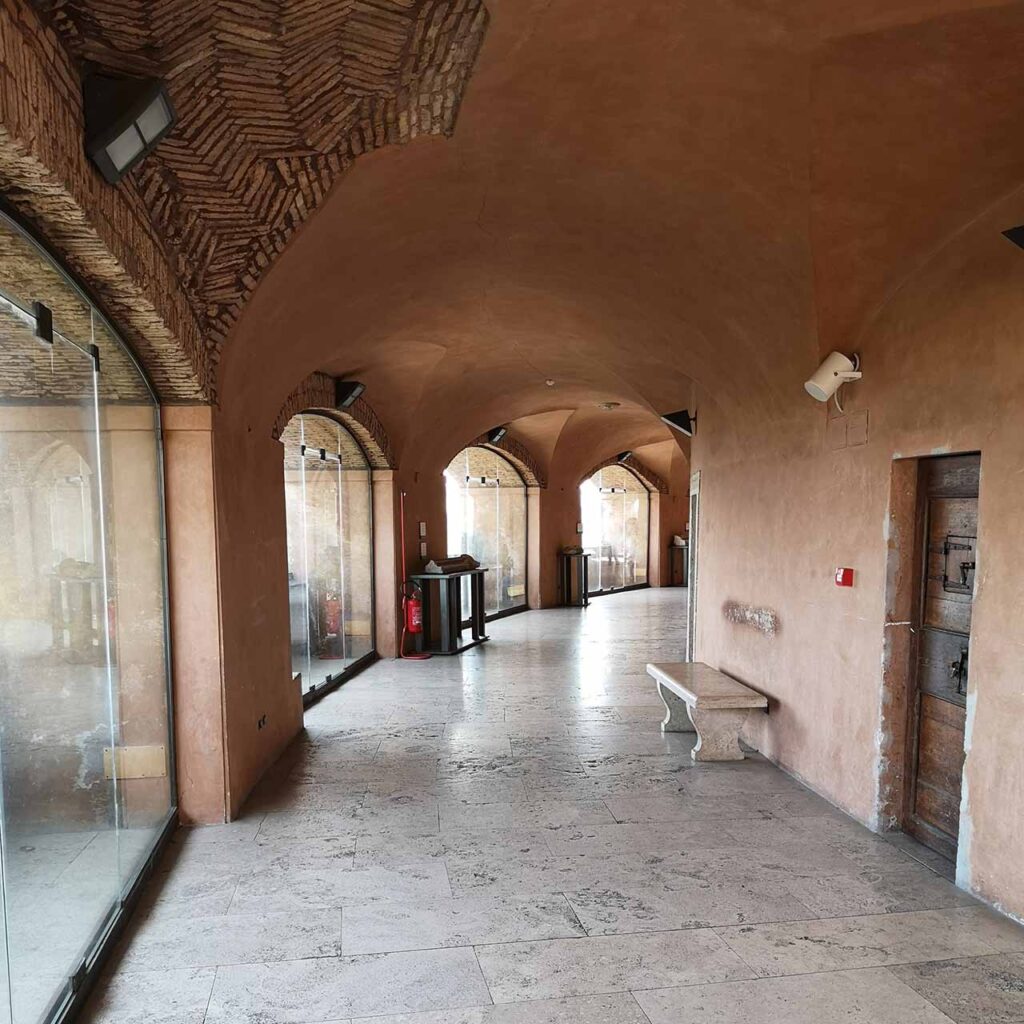
Opening onto the corridor are small doors giving access to the upper level of the building of the Alexander VI’s Rooms. Originally the service of the artillery, these small interconnecting rooms were later used as prisons of honour.
The second of the small rooms led to the small room used for heating the Bath of Clement VII.
The rooms currently open to the public only on the occasion of temporary exhibitions.
The corridor, on the other hand, houses part of the archaeological gallery of the Castel Sant’Angelo National Museum.
Through the masonry arcades, it is possible to enjoy the view of the exterior of the castle.
The Loggia of Paul III
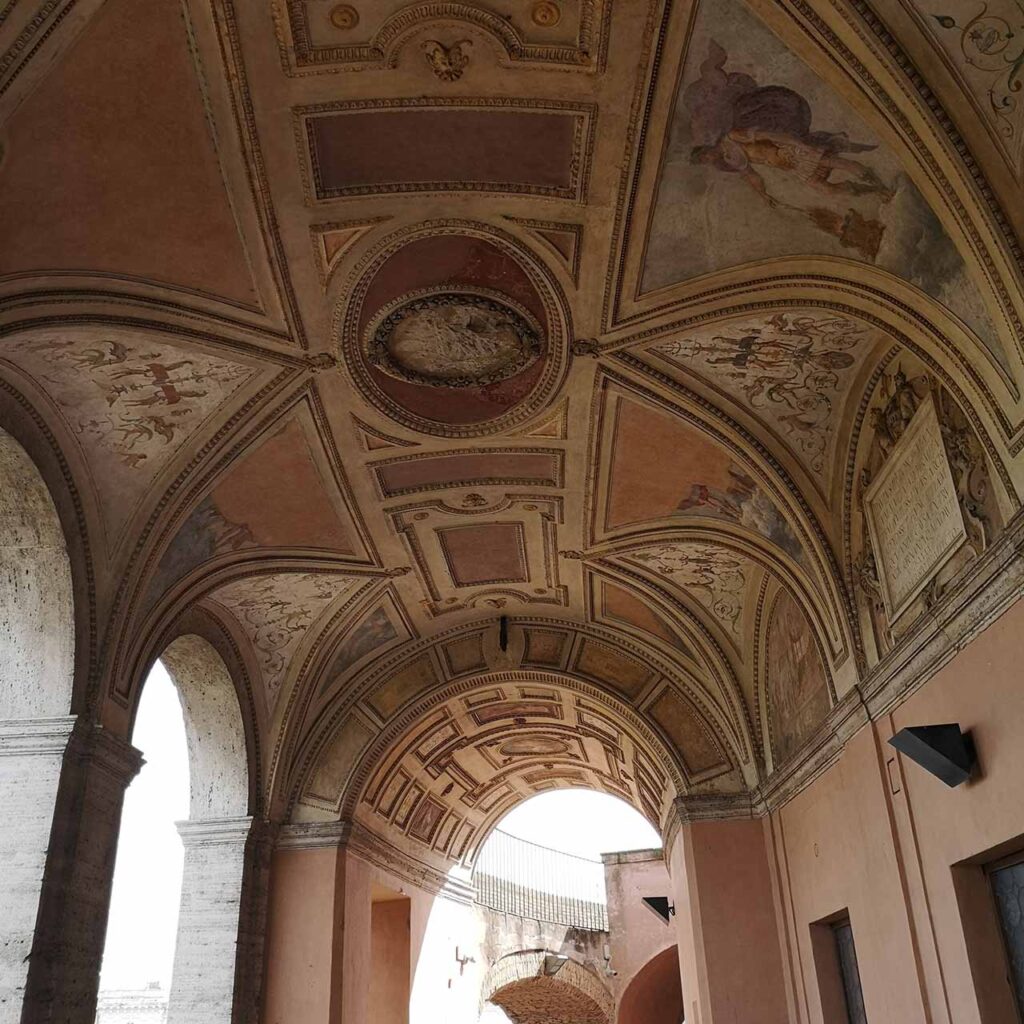
Completed in 1543, this monumental room was the entrance to the flats of Pope Paul III.
The Loggia is formed by five arches supported by pilasters, externally decorated with a relief frieze bearing lilies, the motif of the Farnese family.
Inside, the large barrel vault is decorated with frescoes by Giorolamo Siciolante da Sermoneta.
The six sails are decorated with grotesques on a light background, while the pinnacles depict scenes from the life of Emperor Hadrian.
The two lunettes on the inner wall contain depictions of the Mole Adriana and the Villa Adriana.
At the centre of the vault, framed in stucco, we now find only a remnant of the stem of the pontiff.
The “Giretto” of Alexander VII
Between the Loggia of Julius II and the one of Paul III you can find the Loggia of Alexander VII. Also known as the Uncovered Giretto, this circular corridor is accessible from the staircase that rises from the Cortile dell’Angelo.
Commissioned by Alessandro VII Chigi in the mid-17th century, the Giretto was built on an existing davilion, to which the present arched wall structure was added.
The corridor faces west from the outside; through it is possible to access the rooms of the Upper Armoury and the cafeteria of the National Museum of Castel Sant’Angelo.
The Sala Paolina

The Sala Paolina was the personal salon of Pope Paul III Farnese, whose name it still bears today. Emperors, kings, ambassadors and consuls from all over the world were hosted here.
The decorative ensemble of the room represents one of the greatest artistic episodes of the Roman 500s. The work was entrusted to Perin del Vaga, who carried it out between 1545 and 1547 with the help of a number of illustrious collaborators, including Pellegrino Tibaldi, Luzio Luzi, Domenico Rietti and Giacomo Bertucci.
The frescoes depict scenes from the lives of the pope’s ‘namesakes’, Alexander the Great and St. Paul, who would have been linked to the pontiff.
The vault is very rich: at the centre we find the stemma of Paul III and all around a complex of grotesque panels, stucchi, papal assemblages and cartiglia bearing inscriptions in Greek, bearing witness to the humanistic culture of the pontiff.
Six fresco panels, by Marco Pino, depict important episodes from the life of Alexander the Great;
Beneath the cornice, along all four sides of the rectangular room, runs a written Latin inscription celebrating the restoration of the old Mole Adriana and construction of the Papal Residence.
On the walls we find a feint architecture, composed of Ionic columns and niches housing the allegorical figures of the Cardinal Virtues of Strength, Justice, Temporance and Prudence.
These are alternated with panels depicting other Stories of Alexander the Great, while above the ports are illustrations of six Stories of St. Paul.
At the centre of the short walls, majestically frescoed are the portraits of the Emperor Hadrian and the Arcangel Michael sheathing his sword, homage respectively to the founder and the Christian protector of the place by Girolamo Siciolante da Sermoneta and Pellegrino Tibaldi.
The floor that we see today is more recent; the original terracotta floor was replaced in the 1820s by Innocentence XIII, whose papal coat of arms still stands in the centre.
The generally solemn tones of the room’s decorative apparatus are mitigated by two trompe-l’oeil doors from which a courtier (according to some, the architect Antonio da Sangallo il Giovane) and some servants descend a staircase with a basket of fruit.
Beneath the portrait of Saint Michael the Archangel, two baboons pop up: according to some in memory of a homage from some foreign ambassadors to the pontiff, according to others to suggest the name of the author Giacomo Bertucci, as a signature.
For more information, read my article on the Sala Paolina and adjacent rooms.
The Hall of Perseus

The Sala di Perseo was the study of the pontiff Paul III. The ceiling and the upper part of the walls were decorated by Perin del Vaga and his team.
The ceiling is coffered, with grotesque motifs and heraldic symbols; in the centre stands, in relief, the figure of St. Michael the Archangel.
In the Fregium it is Perseus who takes centre stage. With six large panes, the fresco depicts many of the events of the Greek hero taken from Ovid’s “Metamorphoses”.
The scenes are set in a faux architecture of framed frames and counterframes, with fruit festoons, masks and flowers. Alternating with panels depicting Perseus are monumental maidens with unicorns, emblems of the Farnese.
The mythological cycle should be “read” from the left of the entrance, where we find the “Hero’s Farewell to the Mother Danae” and “Perseus Receiving the Gifts of Mercury and Minerva“, and then proceeding clockwise to the last episodes on the door to the Sala Paolina: “The Return of Perseus“, “The Origin of the Coral” and the “Nuptial Banquet of Perseus and Andromeda“.
Today, in the room we can also admire part of the rich Castel Sant’Angelo collection of works, including the Christ Blessing and the St. Onofrio by Carlo Crivelli, the St. Jerome by Lorenzo Lotto and the Lamentation over the Dead Christ by an unknown author.
The room communicates with the underlying Bathroom of Clement VII and the pontiff’s adjoining bedroom, the Room of Cupid and Psyche.
For more information, read my article on the Sala Paolina and adjacent rooms.
The Hall of Cupid and Psyche

The Hall of Cupid and Psyche (Sala di Amore e Psiche) was the bedroom of Paolo III Farnese. The decoration of the ceiling and walls was entrusted to Perin del Vaga.
The coffered ceiling, with grotesques on a gold background and lilies alternating with targets with the name of the pontiff, has at its centre, in relief, the great Farnesian coat of arms.
On the frage, framed by false corbels and curtains, we find nine panels depicting as many episodes from the fable of Cupid and Psyche as narrated in The Golden Ass by Apuleius, to which is added a tenth scene, painted over the window.
The panels alternate between big winged victories and panels with grotesques on a gold background.
The scandalous presence of such a sensual story must be explained by reading the fable through the eyes of the pontiff, who, with his strictly neo-Platonic culture, gave it a strongly allegorical reading in Christian key.
However, the sensuality of the tale remains explosive in scenes such as ‘Psiche discovers Love and Love flees‘, the most famous of the entire cycle.
In addition to the splendid frescoes, the room currently houses important works such as Christ Carrying the Cross by Paris Bordon and The Bath by Giovanni Luteri, known as Dosso Dossi.
For more information, read my article on the Sala Paolina and adjacent rooms.
The Armoury
The Upper Armoury, consisting of four interconnected rooms, houses part of the collection of war material of the National Museum of Castel Sant’Angelo.
Many of the relics preserved here, such as the sword and the Lansquenet dagger scabbard, were recovered during the excavations carried out in the early 20th century to modify the banks of the Tiber.
In addition to these, there is a great deal of material purchased directly from the Museum or donated to it, such as the wheel-terzetta, of Saxon craftsmanship, and the Bolzano Helm.
The collection includes weapons and armour dating from the Palaeolithic to the 18th century, such as the Archibugio Farnese and the Stendardo dei Bombardieri di Castel Sant’Angelo, and contains a section dedicated to the Risorgimento in which we can find, among other things, a Guaribaldian uniform and a pistol that belonged to Giuseppe Garibaldi.

Skip-the-line ticket Castel Sant’Angelo Rome: fast access
Buy online. Choose your preferred time. Visit Rome’s Castel Sant’Angelo, the Ponte dell’Angelo, the prisons and much more.
You can cancel free of charge up to the day before the visit.
Level 6
At level 6 you will find the Pompeian Corridor, the Library Room, the Adrianean Room, the Hall of Festoons, the Treasury Room, the Cagliostra and the Castellan’s Apartment. Let’s go!
The Pompeian Corridor
Created in the XVI century from a wooden gallery, the Pompeian Corridor is the narrow passage connecting the Paoline Room to the Library Room.
It earns this name thanks to the rich grotesque decoration that covers both its walls and the barrel vault.
The frescoes were executed between 1545 and 1546 by Luzio Luzi and Perin del Vaga, assisted by high-calibre artists such as the Flemish Cornelis Loots, to whom we owe the small Nordic landscapes on the lower part of the walls, and Cristofano Gherardi da Borgo San Sepolcro, author of some other figures in the grotesques.
The Library Room

The salon is the main room of the north wing of the apartments of Paul III Farnese. It only gained its name in the Nineteenth Century, probably in connection with its proximity to the Treasure Room, home not only to the Heritage, but also to the Papal Secret Archive.
The decorative apparatus was entrusted by the pontiff to Luzio Luzi. On the eastern wall we can see a large fireplace and, above it, the imposing allegories of the Church and Rome with the Papal crest in the centre.
The wide vault, decorated with stuccoes and grotesques, is divided into five concentric registers and framed by two continuous friezes.
The former is composed of twenty-eight relief lunettes alternating pagan depictions with Farnesian assemblages, while the latter, located a little higher up, is painted with sea creatures and interrupted, at the centre of each wall, by stucco medallions.
In the vault, alternating with grottes on a white background, are ten Stories of Ancient Rome.
On the short sides are portraits of St Michael the Archangel and the Emperor Hadrian. At the centre, flanked by the embodiments of the Virgin with a Unicorn and the Lily of Justice, we find the Farnese coat of arms.
The Hall of the Hadrian
Through the Library Room one enters the small room of the Hadrian Room, a room that owes its name to the mural paintings that emerged during the restoration of Castel Sant’Angelo in 1902.
Together with the adjacent Sala dei Festoni, it was one of the first rooms built by order of Paul III.
On the top of the walls we find a frey made by Luzio Luzi and his team between 1544 and 1545.
The frieze depicts scenes from mythology and figures of satyrs. At the centre of each wall, framed by faux architecture, we find views of ancient Roman monuments such as the Naumachia of Domitian, the Meta Romuli, the Cirque of Caligula and Nero and the Mausoleum of Hadrian itself.
Another eight panels, two on each wall, depict scenes from the Dionysian world, populated by anthropic gods, satyrs and maenads.
The Hall of Festoons
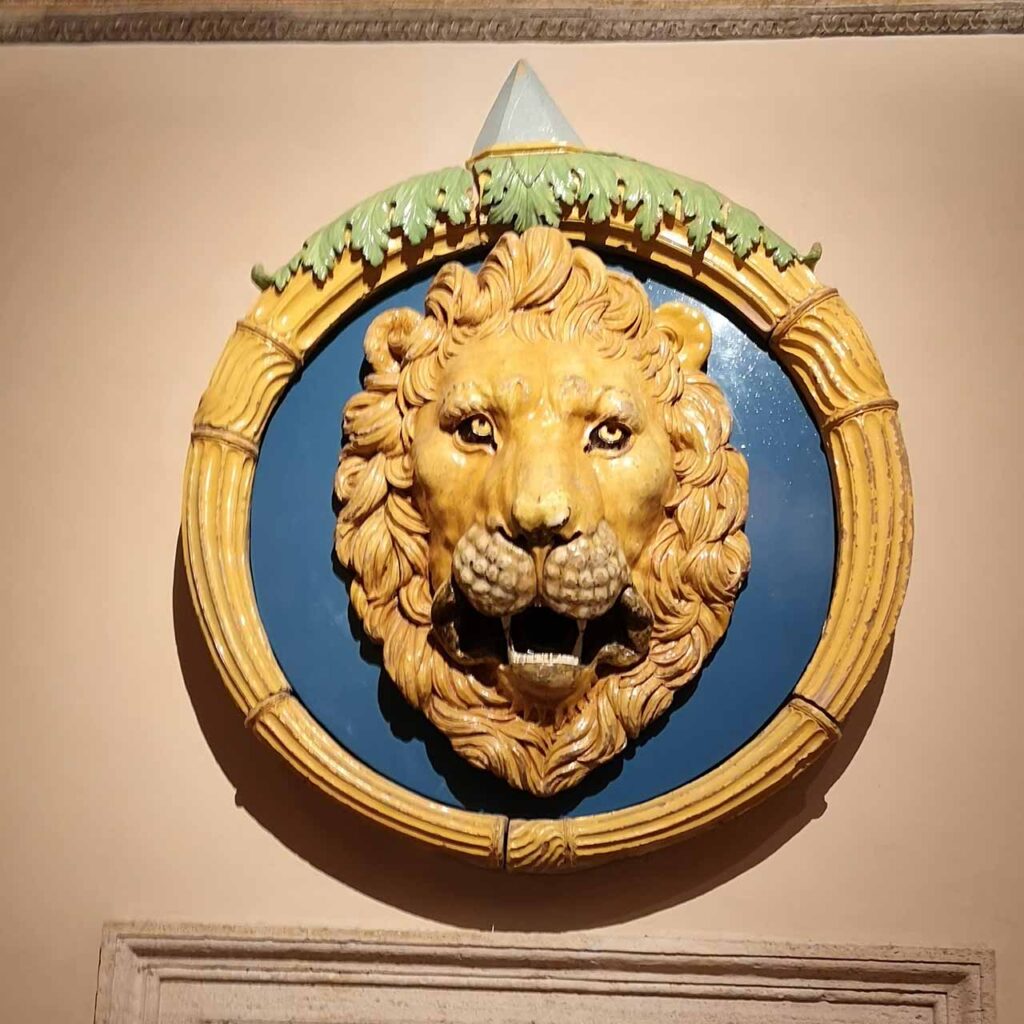
This salon, which only gained its current name in the Nineteenth Century, is also characterised by a rich decorative frieze placed on the top of its walls.
The currents of nereids and dancing tritons, alternating with male, female and unicorn figures, suggest a continuous, undulatory movement: hence the name ‘of the Festoons‘.
The wonderful paintings are once again the work of Luzio Luzi and his team of artists.
Unfortunately, the original ceilings that completed the decoration of the room similar to what can be seen in the Hall of Perseus and the Hall of Cupid and Psyche have not survived to this day.
The hall is connected by stairs to the utility rooms of the Court of Alexander VI and the Cagliostra.
The Treasury Room
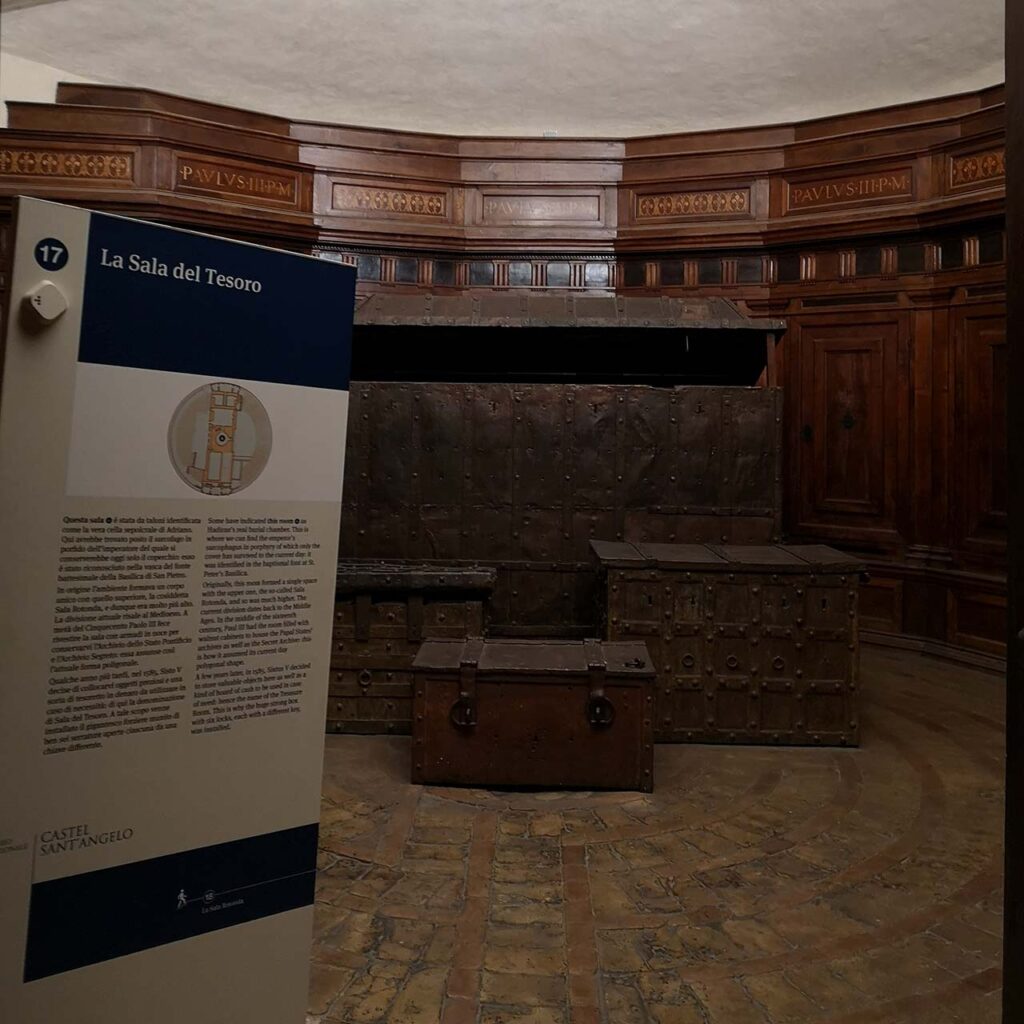
The Treasury Room is a circular room that was the seat of the Treasury and the Secret Archive of the Papal State.
In 1545 Paul III Farnese altered the room by having a bank of walnut cabinets anchored to the masonry to store archive material.
There are records of a golden reserve preserved in the fortress dating back to the end of the 15th century.
In 1586 Sixtus V Peretti had the monumental iron chests placed in the room containing the Sanctionary Treasury, the tesoro for the defence of the State.
The room was accessed through two doors, whose keys were held by the Secret Treasurer of the Pope and the Cardinal Dean.
The treasure was stored in a huge chest protected by no less than six locks.
The hall was converted into a cell during the XIXth century.
La Cagliostra
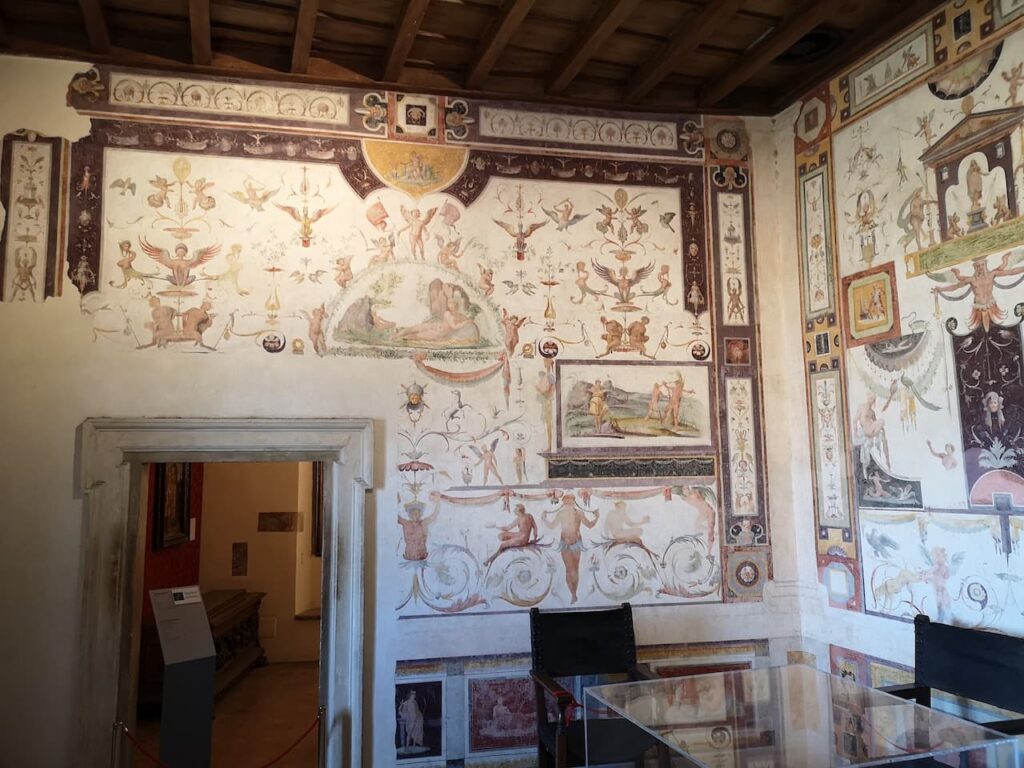
This room was built in 1543 together with the Loggia of Paul III below.
Initially, its arches opened towards the Burg of Prati, but in the XVIII century they were murdered to convert the room into a prison for prisoners of note.
For it was here, in 1789, that the adventurer, esotericist and alchemist Italian Giuseppe Balsamo Conte di Cagliostro was incarcerated by the Inquisition for about a year.
The small apartment consists of three rooms: one large, central room and two side rooms.
From the heraldic emblems of Paul III, depicted at the centre of the faces, the two dressing rooms are named the Dolphin and Salamander Cabinet and the Stork Cabinet.
The grotesque decoration of the interior walls, in typical Renaissance style, depicts a celebral landscape inhabited by celestial figures and bears the signatures of the illustrious painters Luzio Luzi and Perin del Vaga.
The Castellan’s Apartment
The construction of the Castellan’s Apartment on two levels was commissioned by the castellan Zenobio Savelli in the middle of the 18th century.
The castellan was in fact the highest authority of Castel Sant’Angelo, as well as the military head of its operation.
The flat was built above the Loggia of Julius II. In the upper part we find three interconnected rooms, known as the ‘verso San Pietro‘, the ‘stanzino di mezzo‘ and the ‘verso Ripetta‘.
The vault of the central room is decorated with the stemmas of Benedict XIV Lambertini, while those of the side rooms bear the symbols of the Savelli family.
The two small rooms below were connected by passages that are now interrupted. Two more private chambers were carved out above the rooms of Perseus and Cupid and Psyche, bringing the number of rooms in the flat to seven.
In 1746, under the pontificate of Benedict XIV, a large clock was placed between the two central windows of the flat, which was removed almost two centuries later.
The flat currently houses the permanent exhibition dedicated to the impressive firework display of the Girandola. If you are interested in discovering the history of this legendary event, don’t miss the article on the Girandola of Castel Sant’Angelo.

Skip-the-line ticket Castel Sant’Angelo Rome: fast access
Buy online. Choose your preferred time. Visit Rome’s Castel Sant’Angelo, the Ponte dell’Angelo, the prisons and much more.
You can cancel free of charge up to the day before the visit.
Level 7
At level 7 you will find the Round Hall, the Hall of Columns and the Angel Terrace (Terrazza dell’Angelo). Let’s go!
The Round Room
Located above the Treasure Room, with which it formed a single room, the Round Room owes its name to its circular shape.
The room is reached by means of a narrow staircase dating back to Roman times, which starts from the Library Room, and is traditionally believed to be the seat of the first chapel dedicated to St. Michael the Archangel.
Over the centuries, the room has undergone many changes. Under Clemente VIII it was used to house the extension of the Paptifical Secret Archive. Its walls were lined with wooden cabinets with metal locks, now lost; access was only granted by means of a iron door.
Currently, at the centre of the room, we can admire the original metal support of the statue of St Michael the Archangel by Peter Anton Van Verschaffelt, which was replaced during its last restoration in 1987.
The hall also hosts temporary exhibitions.
The Hall of Columns
Built to house the New Archive of the Papal States under Benedict XIV, this room takes its name from the four columns that embellish it.
It consists of a spacious room and two adjoining dressing rooms, the Cavalry Banners Room and the Assault Wards Room.
The original furnishings included walnut credenzas and tables for use by the archivists. The windows were fitted with removable hatches to protect them from the fireworks that took place on the Terrazzo dell’Angelo above.
In July 1789, on the occasion of the French occupation by the troops of General Louis Alexandre Berthier, the documents of the archive were transferred to the Vatican via the Passetto di Borgo. During the following year, the entire archive was destroyed.
The decoration in tempera of the volte was created on the occasion of the establishment of the first museum in Castel Sant’Angelo in 1925, while the trompe l’oeil decoration in naturalistic theme by Duilio Cambellotti dates from the following year.
The decorations of the Cavalry Banner Room and the Labar Room of the Assault Troops, on the other hand, have a purely patriotic and warlike background, with flags, assemblies and banners from various eras of national history, horse heads and armed arms.
To date, the rooms are the venue for temporary exhibitions.
The Angel’s Terrace
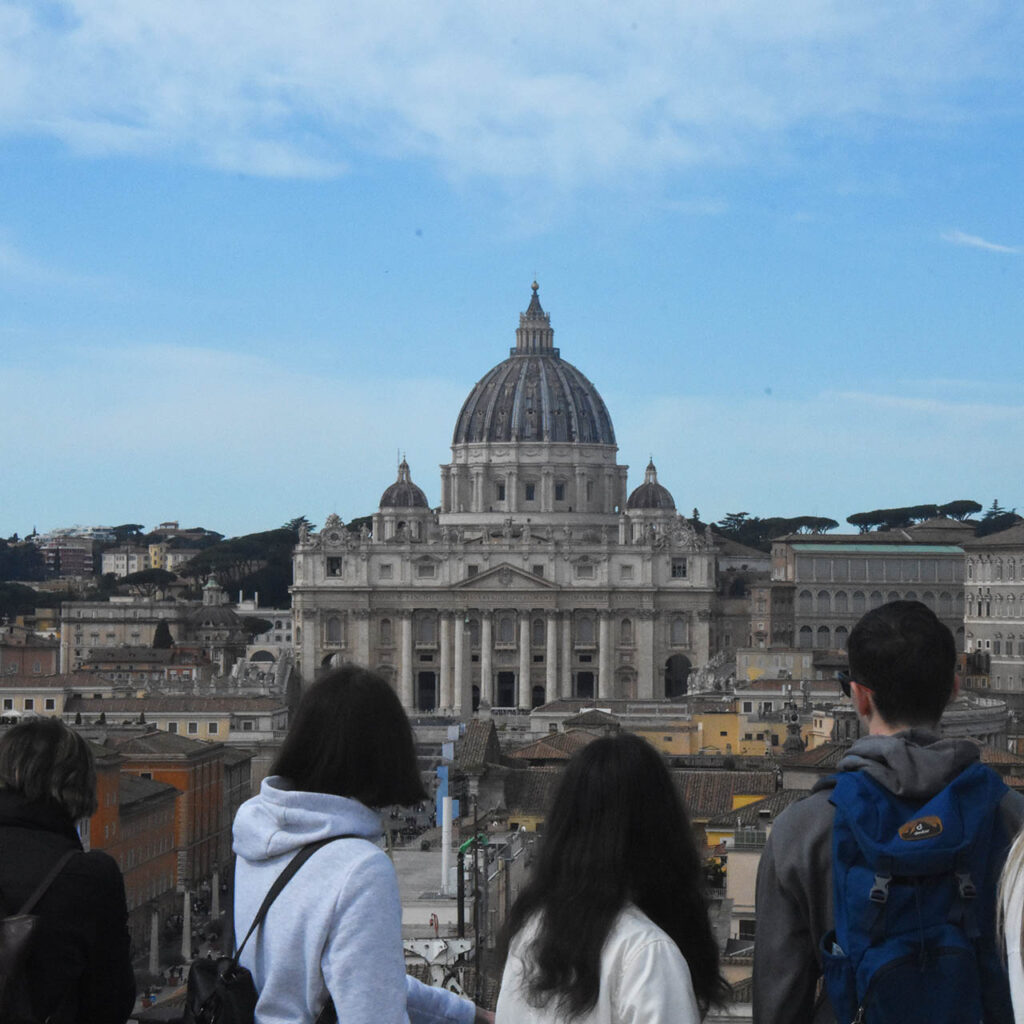
Among the most popular Viewpoints in all of Rome, the Terrazzo dell’Angelo is the highest accessible point in Castel Sant’Angelo.
This overlook owes its name to the colossal statue of St Michael the Archangel that has dominated it for centuries. After being replaced several times, the current bronze sculpture, which stands on the castle’s ‘male’, was made in 1752 by the Flemish Peter Anton van Verschaffelt.
From 1758 comes the bronze bell flanking the statue, known as the Campana della Misericordia or dei Condannati, which rang out at executions held in the Cortile delle Fucilazioni.
Since the XVth century, on special occasions, fireworks have been held on this terrace, known as ‘d’allegrezza’ or ‘Girandole‘ according to Michelangelo’s famous definition.
From here one can enjoy an unprecedented panoramic view of the centre of historic Rome and can follow the entire route of the Passetto di Borgo from the castle to the Vatican Palaces.

Skip-the-line ticket Castel Sant’Angelo Rome: fast access
Buy online. Choose your preferred time. Visit Rome’s Castel Sant’Angelo, the Ponte dell’Angelo, the prisons and much more.
You can cancel free of charge up to the day before the visit.
Castel Sant’Angelo: Legends

There are numerous legends concerning Castel Sant’Angelo, and all of them are linked in some way to its history.
From 590 A.D., for instance, the Mole Adriana is called ‘Castellum Sancti Angeli‘. Why?
According to tradition, in that very year, Rome was struck by a plague epidemic. In the streets, citizens rumoured that an angel and a devil roamed the city.
Newly installed Pope Gregory the Great called a penitential procession and prayed that the city would be freed from the affliction.
At the head of the procession, just as he is crossing the Ponte Elio, the pontiff has a vision: he sees in front of him, at the top of the Mole Adriana, the archangel Michael sheathing his sword.
For him there is no doubt, it is a divine sign. The epidemic, he announces, has its days numbered. And this proves to be miraculously true.
In remembrance of the event, the castle changes its name, as does the bridge connecting it to the other side of the Tiber.
At the top of the Castel Sant’Angelo, a chapel was built and dedicated to the Angelo replaced, towards the end of the 11th century, by a wooden statue.
But this is not the only legend concerning the castle, there are others related to magic and even ghosts! If you want to know more, read my article on the legends of Castel Sant’Angelo.
Castel Sant’Angelo: Curiosities
Not only legends, but also many curiosities!
Did you know, for example, that the statue that gives the name to the castle has not been the same since forever?
The first angel statue, in fact, is built of wood, but atmospheric phenomena end up destroying it.
A second marble one followed, destroyed during a riot in 1379.
The third, also made of marble but with bronze wings, shattered when a lightning bolt hit the castle and blew up a gunpowder store.
In 1497 a bronze statue was opted for, but in 1527 the need for warfare dictated that it be fused to make cannons.
In 1573, another marble version was built with the bronze wings, which was then, in 1752, replaced by the current bronze statue made by the Flemish sculptor Peter Anton von Verschaffelt.
I told you about the historic prisons above, but have you ever heard of the terrible cell of Sammalò? Situated at the rear of the St. Mark’s bastion, to enter it the convict was calculated from above and had not enough room to be able to stand, nor to corculate!
But there are so many curiosities involving Castel Sant’Angelo, it would be impossible to summarise them. Fortunately, I have written an article on just that. Run and read my article on the curiosities of Castel Sant’Angelo.
Castel Sant’Angelo: Brief History
Begun as the sepolcro of the Emperor Hadrian, it was finished by Antoninus Pius in 139 AD and fulfilled its original function for hundreds of years.
Around 403 AD, the Western Emperor Onorius had it included in the Aurlian Walls: from this moment on, the tomb became a defence bulwark, losing its commemorative value and assuming a strategic one to protect the Eternal City.
It was on this very occasion that it first earned the appellation of “castellum“, but it was not until 590 AD that, according to the legend, it found its current name.
Many Roman families fought for the possession of the castle. In the first half of the 10th century it was the fortress of Senator Theophylact, in the second half it was for the Crescenzi, who fortified it and gave it their name, It then passed to the Pierleoni family, and afterwards to the Orsini, to whom it was probably given by Pope Nicholas III, a member of the same family, after he had the Passetto di Borgo built, connecting it to the Vatican.
In 1367 it was Pope Urban V who was given the keys: from this moment on, the structure would serve as a refuge for the popes to come, would house the Archive and the Vatican Treasury, and would be a tribunal and prison.
In 1379 it was almost razed to the ground, and in 1395 it was rebuilt and upgraded by the military architect Niccolò Lamberti by order of Pope Bonifacio IX. For four centuries the interventions would follow one another, new structures would be added, and existing ones would be reconstructed.
After the Unification of Italy it will initially be used as a caserne, then become a museum. It will be restored by the Genius of the Royal Army and will house the Military Engineering Museum. During the Ventennium, the bastions and ditches will be restored and several halls will be arranged.
Today, the Museum of Castel Sant’Angelo houses numerous collections of ceramics, paintings and sculptures, and is the centre of courses, initiatives and educational activities that promote awareness of the Museum among the general public.
If you want to learn more about the history of the castle, read my article on the history of Castel Sant’Angelo.

Skip-the-line ticket Castel Sant’Angelo Rome: fast access
Buy online. Choose your preferred time. Visit Rome’s Castel Sant’Angelo, the Ponte dell’Angelo, the prisons and much more.
You can cancel free of charge up to the day before the visit.
Interior of Castel Sant’Angelo Rome: FAQ
Inside the Castel Sant’Angelo, you can still admire the Tomb of Hadrian, the circular staircase, the Papal lodgings, the frescoes, the campus of executions, the Grande Loggia, the bastions, the well-preserved fortress rooms, and much more.
The entrance tickets to the National Museum of Castel Sant’Angelo have varying prices depending on the desired ancillary services.
The price of the standard ticket with reserved entrance starts at €20, with the addition of the audioguide the basic price rises to €32, while the cost of the guided tour starts at €37.
You can also buy a combined ticket with other attractions in Rome or the Vatican.
If you are staying in Rome for a few days and don’t want to miss anything, you may find it convenient to purchase the Rome Pass (from €55) or the Rome Tourist Card (from €95).
The visit of Castel Sant’Angelo lasts an average of 1 hour and a half, but on the occasion of temporary exhibitions, or if you are a enthusiast or a student of artworks, you may take more time to visit the Museum.
Admission is free every first Sunday of the month. No reservations are required on free admission days.
What to See in Castel Sant’Angelo: Conclusions
Here we come to the end of this long survey on the Interior of Castel Sant’Angelo;
In the article, I wanted to describe in detail all the environments of the castle, those that are always accessible and those that open only on special occasions;
Together we breathed in the history in brief of the fortress, we were fascinated by the Legend of the Angel and other curious stories about the castle and the famous people it has hosted over the centuries;
To conclude, I have answered some of the most frequently asked questions about the castle and the visit to the National Museum of Castel Sant’Angelo.
If you need more information, please leave a comment below; if you would like to visit the Castle and its interiors, purchase your entrance ticket by cutting the queue at the ticket office.

